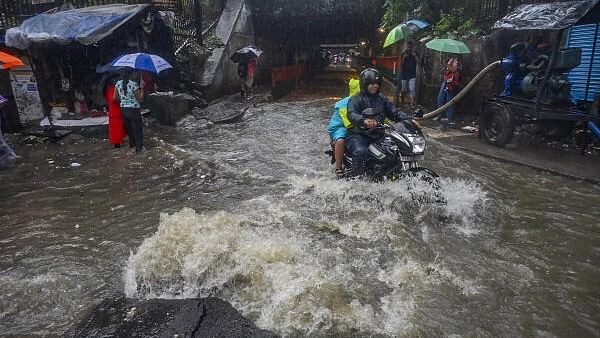
Commuters on a waterlogged road amid rain in Mumbai.
Credit: PTI Photo
New Delhi: More and intense low-pressure systems, especially in August and September, resulted in 8 per cent more rainfall than usual in India during the 2024 monsoon season, the India Meteorological Department (IMD) said on Tuesday.
The southwest monsoon season officially ended on Monday, with the country recording 934.8 mm of rainfall compared to the normal 868.6 mm -- the highest since 2020.
IMD data showed that 14 low-pressure systems impacted the country this monsoon, compared to the average of 13. These systems were active for a total of 69 days, against the normal 55 days.
Out of these 14 systems, five strengthened into depressions or deep depressions, and one became a cyclonic storm.
“After a long time, we have seen so many depressions during the monsoon. This is why there has been good rainfall across the country,” IMD Director General Mrutyunjay Mohapatra said during a virtual press conference.
Six low-pressure systems developed in August and three in September, making the second half of the monsoon season much more active.
Rainfall was 2 per cent higher than normal in June and July, while August and September saw 12 per cent above normal.
Mohapatra added that India did not experience any "break monsoon" conditions this year because of the large number of low-pressure systems.
He said that the higher rainfall in Rajasthan and Gujarat was due to the frequent formation of low-pressure systems, including six depressions, which moved along longer paths than usual.
“Most of these systems moved southward and traveled across central India to reach Rajasthan and Gujarat, causing heavy rains there,” he said.
The monsoon trough (a band of low-pressure areas) mostly stayed south of its normal position, which helped bring more rain to central and southern parts of India. It only shifted towards the Himalayas in September, he said.
Regionally, central India received 19.5 per cent more rain than usual, the southern peninsula saw 14 per cent more, and northwest India recorded 7 per cent above normal. However, eastern and northeastern India got 14 per cent less rain than expected, the IMD said.
Rainfall in June was 11 per cent below normal, but July saw 9 per cent more rain, August had 15.3 per cent extra, and September recorded 11.6 per cent more than normal.
Only three of India's 36 meteorological subdivisions had less rainfall than normal this season. Twenty-one subdivisions saw normal rainfall, 10 had excess, and two reported large excess.
Rajasthan, Gujarat, western Madhya Pradesh, Maharashtra, Telangana, and Andhra Pradesh were among the states with more rainfall than usual, according to Mohapatra.
In 2023, India recorded 820 mm of rainfall, which was 94.4 per cent of the long-period average. In 2022, the country received 925 mm (106 per cent of the LPA), 870 mm in 2021, and 958 mm in 2020.
The IMD had predicted above-normal rainfall (106 per cent of the LPA) for the 2024 monsoon. It also accurately forecast below-normal rainfall for northeast India, normal rainfall for northwest India, and above-normal rainfall for central and southern regions.